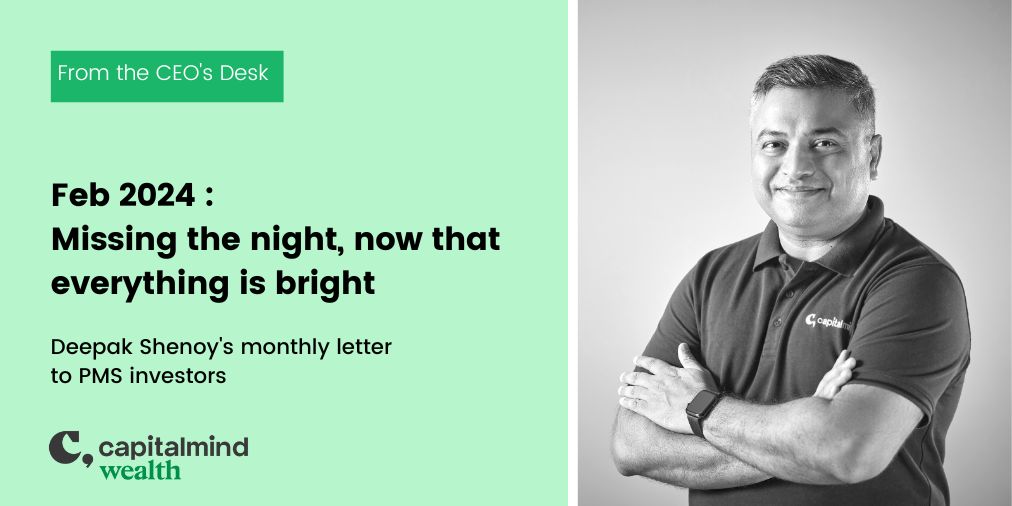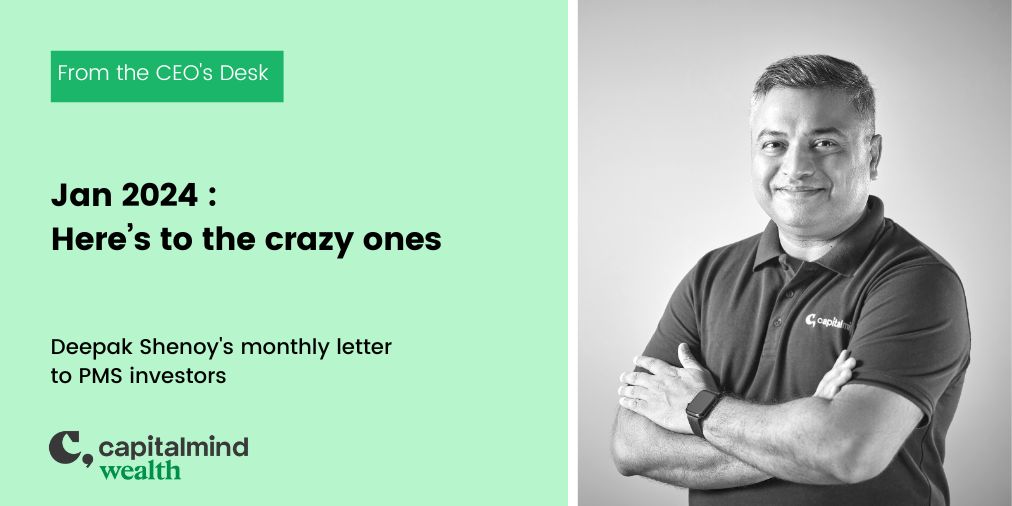[This is an excerpt from the Feb 2022 letter to Capitalmind PMS Clients]
I’ve just finished watching Inventing Anna. It’s a story of…well, a wannabe scam artist who pretended to be a German Heiress and took some high society rich people for a ride. It’s a wicked ride embellished by fancy things made by names that have eternally divorced themselves from their pronunciations. Such as Givenchy and Yves Saint Laurent. In that strange world, where people try hard to build and live up to a reputation and appear classy by a crass display of money, the inspiration to write this note came right at the very end. It involves Frank Sinatra.
Anna’s lawyer made a statement that her false claim was only about trying to get people to believe, so that she could get her business off the ground. Even Sinatra, he said, did it.
Sinatra’s publicist, George Evans, didn’t want to risk that people would love Frank – so he hired girls to scream loudly at strategic places in the audience to build excitement. (Link) The concept has stuck on heavily to the world at bay – we have normalised the concept of “fake it till you make it”.
An ecom company builds fake orders through known people and generates more “GMV” (gross merchandise value)? No problem, say the investors. They’re hustling. A company that shows “community adjusted EBITDA” by removing all expenses? No problem, because why else would big names have funded you? At a smaller level, we’ve seen the faking of employment histories, education certificates, and even birth certificates in cricketing circles. (From someone I know in the cricketing world, the under-14 age group is so competitive that parents get fake birth certificates so their older kids can qualify) It’s all okay if it works out at the end – a new funding round, an IPO or a couple extra centuries.
In this world, it’s important to see beyond the obvious, because the obvious is probably built as a story someone wants to sell you. Russia is attacking Ukraine, it seems. What we’ve been told is that Russia wants a buffer against NATO. Or because Ukraine promised to keep the eastern states partly independent but now reneged on that. Or because Putin is a megalomaniac that wants to bring the Russian empire back, depending on which publication you read.
If you read the other side, it’s about how the US and UK want to stymie the new Nord Stream 2 pipeline that will get gas from Russia directly into Germany (currently the pipeline goes through Ukraine and other countries who take a piece of the pie). Because Russia will then control more of Europe’s energy and won’t buy as much from the US. Or because Biden is only getting back at Russia because they supported Trump.
The real story is probably a complex mix of all of the above, or could even be a “none of the above”. What has happened is that gas and oil prices have gone through the roof, in fear. And Russia’s greatest export is oil – giving them $141 billion dollars of exports in 2020, when oil prices were half of the current levels. If prices remain at $90+ we will see massive oil flows. With the slowing of the new pipeline to Europe, Russia will only gain if natural gas prices were to rise. It’s unlikely that there is a third world war on this front – fatigued from all the loss of life, no western state is going to want to do anything dramatically more than “I told you so” while thinking of how to get back to normalcy quickly.
This crisis will of course weaken stock markets, until it’s over. It should be over relatively soon, because Russia is simply too big to be messed with. In the process, the markets will look for the first signs of an end, until they become less jittery.
However, the question is: is Ukraine this important that the markets collapse? Does it matter? Let me tell you this, from experience. Imagine a car’s engine temperature gauge is showing it’s overheating but a driver continues to run the car on full throttle. A small pothole appears, and the car jerks and stalls. Was it the pothole or the overheating car?
A lot of stocks had reached very high valuations, and some could simply not sustain. At a time like this, it isn’t a Russia invading Ukraine that is the problem. It’s the overvaluation that’s finally correcting. The Nifty’s only corrected about 10.5% from the top it made in October, but that masks something far worse underneath.
The average correction of stocks in the Nifty, from their own 52 week high, is over 18%! Many stocks like HDFC Bank, which we think are “stable” are now down way more than the Index is, and only 6 stocks have drawdowns of less than the Nifty.
What you see is the fall in the Nifty of only 10% and wonder, what’s the big deal? But the true story lies hidden underneath – average damage of 18%, with many stocks down more than 25%.
(In the Nifty 500, more than 200 stocks are down 20% or higher from their one-year highs. In fact, more than 180 stocks are down more than 30%!)
The Nifty hides away all of this from us, and presents a picture that’s more glorious. It’s the same in the US, with the Nasdaq 100, being top heavy. And a significant amount of the damage was done way before Putin woke up on the wrong side of his bed and blamed Ukraine.
The price damage has been from a market that was looking at an excuse to correct, and got it. However, does it continue to stay there? Many companies, with their 30%+ corrections, are at better valuations. Margins are compressing in many sectors, but if we see normalisation of crude prices and resumption of supply chains (already happening), we will probably have more stable margins too. Markets may correct, but the underlying base of companies are in far better financial shape than before; total industrial credit is now only 15% (in absolute terms) higher than levels we saw in 2015. In six years, we have seen companies reduce their debt footprints substantially. If there is a crisis, these balance sheets are far more stable than they were earlier.
Hidden away from all of this is that India’s only now starting to resume functioning after Covid. This means more traffic jams, more school reopenings and more office activity, which will bring about some more growth. The fear of a major rate hike by the west is perhaps less furious now, but Indian core yields have already risen about 0.8% to hit 6.8%, all of this in the last three months.
Is it quite as bad as it’s made out to be? The simplest answer is: it doesn’t matter. We will react to what is presented to us, not what is. When the markets went up despite the massive economic damage in the economy, it was partly because people found themselves with nowhere else to spend, with access to markets, and with the thought that the future would be better. That future is here, and things begin to look bleak with the US threatening to raise interest rates, Russia threatening to take away Ukraine’s weapons, and Europe threatening in very soft tones that if Russia keeps doing this, there will be major action (but not in winter because they need the gas)
When you are presented with fear, you will react with fear. And that brings us to risk. Markets have gone up 6 years in a row, and this year is perhaps one of fatigue. As corrections come, some sharp, some slow, we see the impact on the portfolios as they get battered somewhat. Our portfolio and cash approaches at Capitalmind have still kept drawdowns relatively lower than individual stocks, but we believe that once the “fear” is behind us, stability will bring about new trends, momentum, and disruption, all of which are what benefit us.
I’d like to highlight something here: We know markets will correct, but that doesn’t mean that we should forever exit the markets. There is still no reasonable alternative to stocks in the long run, but in the short run there are going to be times when the world is fearful. In Indian markets, you lose money 30% of the time if you look one year after you invest. But the same thing, after 5 years, you lose only 5% of the time. I’m preaching to the choir, because you already know this, but the core lesson is that if your investing horizon is long term, then the times where markets are fearful are times to add, not times to regret.
The scale of inefficiencies in India is high enough that companies will constantly chip away at them and make money. Reliance, for example, is selling direct to kirana shops, cutting off the “wholesaler” middlemen. This causes concern for the middlemen but joy to the kirana shops, who get better discounts, more formal credit and more predictable delivery. The budget has attempted to fix some of the misallocations of the past – by reducing the subsidy to farmers, and increasing capex that benefits the whole country. To benefit from this, you have to be invested in the equity of businesses, which will scale over time.
Meanwhile, nothing is as it seems, because what it seems to be is created to make you react a certain way. You can fight it, or recognise it, but you shouldn’t fall for it. The headline of this post is a statement I heard in The Truman Show: Why doesn’t Truman Burbank (played by Jim Carrey) realize that he can leave a world that was created entirely for him? Because we accept the reality of the world with which we are presented.
The tag line of Inventing Anna is: This story is completely true. Except for the parts that are completely made up. If they had put a bumper sticker on life, that would be just as accurate.
We’ll end with Sinatra because it started with him. The lyrics of his “My Way” end in a note we should all aspire to be. The world will be a better place.
To say the things he truly feels
And not the words of one who kneels
The record shows I took the blows
And did it my way
Authentically,
Deepak
Connect with us! Capitalmind Wealth PMS is India’s lowest-cost Portfolio Management Service for investors who deploy ₹ 50 Lakhs and more. You can read more about our strategies at capitalmindwealth.com and their performance here. Connect with us on connect@capitalmindwealth.com or schedule a call with us by filling out this form





